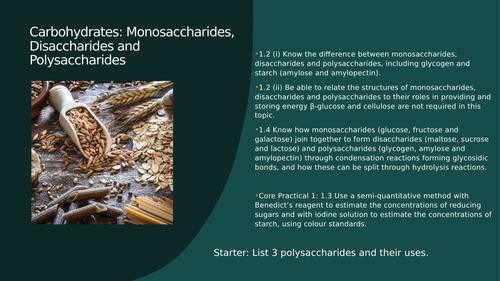

Carbohydrates. Follows the Pearson Edexcel International AS/A Level Specification. Learning outcome:
1.2 (i) Know the difference between monosaccharides, disaccharides and polysaccharides, including glycogen and starch (amylose and amylopectin).
1.2 (ii) Be able to relate the structures of monosaccharides, disaccharides and polysaccharides to their roles in providing and storing energy β-glucose and cellulose are not required in this topic.
1.4 Know how monosaccharides (glucose, fructose and galactose) join together to form disaccharides (maltose, sucrose and lactose) and polysaccharides (glycogen, amylose and amylopectin) through condensation reactions forming glycosidic bonds, and how these can be split through hydrolysis reactions.
Core Practical 1: 1.3 Use a semi-quantitative method with Benedict’s reagent to estimate the concentrations of reducing sugars and with iodine solution to estimate the concentrations of starch, using colour standards.
Contents include:
What are organic compounds?
Monomers and polymers.
Mono-, di- and polysaccharides, and their chemical structures.
Isomers
Bonds between sugars.
Forming and breaking bonds between sugars.
Testing for reducing sugars and starch.
Something went wrong, please try again later.
This resource hasn't been reviewed yet
To ensure quality for our reviews, only customers who have purchased this resource can review it
Report this resourceto let us know if it violates our terms and conditions.
Our customer service team will review your report and will be in touch.